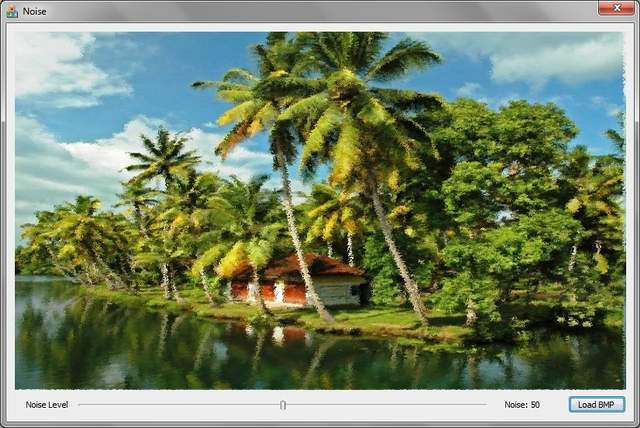
Screenshot of the Noise application
Introduction
This is a simple pixel shader program which changes the input texture coordinate with a noise value and creates a noisy output image.
Background
Creating any effect in an image is very simple with a pixel shader. This article demonstrates a simple noise effect in an image.
Using the Code
A fragment program will be executed for all pixels of a rendering. When rendering an entire texture fragment,
the shader will get the corresponding texture coordinates for each pixel of rendering.
If texture lookup is performed with the provided texture coordinates for display, the rendered image will be the same as the
input image.
An example shader displaying a texture image same as the input image:
uniform sampler2D ImageTexture;
void main()
{
gl_FragColor = texture2D(ImageTexture, gl_TexCoord[0].st );
}
gl_TexCoord[0].st holds the texture coordinate which can be used to get texel (a pixel from texture). After getting
the texel from ImageTexture,
set that color as output color, and we will get the display of ImageTexture in screen.
What will happen if we change the texture coordinate used for texture lookup?
The display of ImageTexture will be slightly changed.
Given below is an example shader displaying texture image with some changes in
display of imageTexture.
uniform sampler2D ImageTexture;
void main()
{
gl_FragColor = texture2D(ImageTexture, gl_TexCoord[0].st +
vec2(0.0, cos( gl_TexCoord[0].s)));
}
This shader can create a change in display of the image, but that’s not good for creating a noisy image. In order to create a noisy output, we need to randomly
change the lookup position. That’s why I created a NoiseTexture which contains random offsets that can be used to change the lookup coordinates
of ImageTexture. The size of NoiseTexture is the same as that of ImageTexture to avoid repetition of
the Noise offset for nearest pixels.
CreateNoise() creates random offsets for filling NoiseTexture.
bool CNoiseDlg::CreateNoise()
{
srand(time(NULL));
if( 0 == m_pnRandomIndexes )
{
int maxRandom = max( m_nImageWidth, m_nImageHeight );
m_pnRandomIndexes = new int[maxRandom];
for (int nIndex = 0; nIndex < maxRandom; nIndex++)
{
m_pnRandomIndexes[nIndex] = max( (int)rand() % 256, (int)1.0);
}
}
FillGrad(1);
BYTE* pbyData = new BYTE[m_nImageWidth * m_nImageHeight *3];
float NoiseHeight = m_NoiseValue / 100.0 * 25.0;
for(int i = 0; i<m_nImageHeight; i++)
for(int j = 0; j<m_nImageWidth; j++)
{
int offset = (i*m_nImageWidth+j)*3;
char value = m_pnRandomIndexes[(j+m_pnRandomIndexes[i]) & 0xFF];
pbyData[offset] = m_nRandomValues[value & 0x1F][0] *
NoiseHeight + min( NoiseHeight, m_NoiseValue ); pbyData[offset+1] = m_nRandomValues[value & 0x1F][1] *
NoiseHeight + min( NoiseHeight, m_NoiseValue ); pbyData[offset+2] = m_nRandomValues[value & 0x1F][2] *
NoiseHeight + min( NoiseHeight, m_NoiseValue ); }
if( !m_NoiseTexture.Create( m_nImageWidth, m_nImageHeight, pbyData ))
{
AfxMessageBox( L"Texture loading failed" );
return FALSE;
}
delete[] pbyData;
return true;
}
For each pixel, offset values are retrieved from NoiseTexture, and
we apply this offset to the original texture coordinate. This new texture coordinate
is used for the lookup of ImageTexture and to get a Noisy output of ImageTexture.
Shader for Creating a Noisy Image
uniform sampler2D ImageTexture;
uniform sampler2D NoiseTexture;
void main()
{
vec4 Noise = texture2D(NoiseTexture, gl_TexCoord[0].st );
vec2 fLookupCoord =
gl_TexCoord[0].st + vec2( Noise.r * 0.065,-Noise.g * 0.025 );
gl_FragColor = texture2D(ImageTexture,fLookupCoord );
}
Points of Interest
In my previous shader program, the release version creates an error while reading
the pixel shader from the resource. When I used strlen()
to find the length of the resource data, some unexpected data is appended at the end of
the resource. Therefore compilation of the shader program fails. I used SizeOfResource() for finding the length of
the Resource data, and fixed that issue.
bool GLSLShader::CreateProgram( const int nProgramID_i, GLenum glSlShaderType_i )
{
AFX_MANAGE_STATE(AfxGetStaticModuleState());
HRSRC hrResInfo = FindResource( 0,
MAKEINTRESOURCE( nProgramID_i ),TEXT("IDR_DATA"));
if( 0 == hrResInfo )
{
return false;
}
HGLOBAL hRcResource = LoadResource(0, hrResInfo );
const CHAR* pBufferResData = (CHAR* )LockResource( hRcResource );
int nLENGTH = SizeofResource( 0, hrResInfo );
}
History
- 4 July, 2010: Initial version.
- 5 July, 2010: Updated binary, since previous binary had dependency with the Visual Studio 2008 Runtime.
